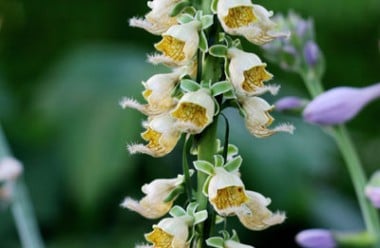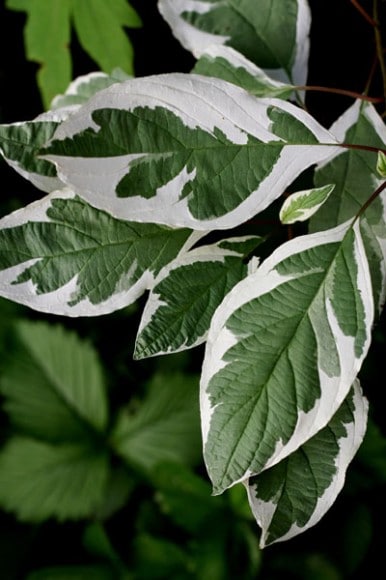
It’s a good day in the garden when a plant I particularly like is generous with self-sown seedlings. A great favourite of mine, the biennial rusty foxglove (Digitalis ferruginea, Zone 5), each year gives me five or six little offspring to move into advantageous positions. Rusty foxglove isn’t among the more glamorous types like Excelsior or Foxy hybrids, which have large pink, rose and lavender bells and heavily spotted throats. (The weight of those fancy bells often pulls the central stem over, and staking is required.) Rusty foxglove stands stiff and straight as a poker, and is encrusted with small, buff-apricot bells with maroon veining in their throats and fuzzy little lips at the bottom edge, just right for honeybee landings. They bloom in light shade where the stems grow to about 24 inches (60 cm); in sun the stalks are huskier and can reach double that height.
Rusty foxglove is a striking architectural plant; a grouping makes an excellent vertical feature. I have some growing beside pink-lavender ‘Katherine’ border phlox (Phlox paniculata ‘Katherine’, Zone 4), and both plants bloom together, with the addition of tall mauve hosta flowerscapes in the background.
Biennial plants grow a rosette of foliage the first year, send up a flower stalk in the second year, then set seeds and die. I purchased only one rusty foxglove plant a few years ago, and always have a few seedlings in their first year of growth, and several in their second (blooming) year. The bells lining the stalks are small, just the right size for a small (non-stinging) wasp or bee to snuggle inside. Sometimes a bee seems to fall asleep in a bell, and stays there overnight. I try to keep my voice down.
The air-conditioner garden
One year, my air conditioner died on the warmest day of the summer. I quickly organized a diagnostic opinion (not worth repairing) and the installation of a new unit the following morning. I was pleased with the swift resolution of this sticky problem, until it became apparent that the old unit couldn’t be removed (or the new one installed), without considerable damage to the plants I’d carefully cultivated to camouflage this mechanical luxury.

There are various ways to conceal an air conditioner. A simple trellis screen is a quick solution or a short, sturdy hedge. But, of course, a gardener is unwilling to surrender good growing space to simple devices, and wants valuable plants that can co-exist for 12 weeks in summer with hot air spewing from a motor and fan. I’ve made an attractive collection of plants in this shady pocket garden, which gets only one hour of direct sun a day. The primary groundcovers are alpine strawberry (Fragaria vesca, Zone 3) and red barrenwort (Epimedium rubrum, Zone 5), and they look good from early spring through autumn. There’s a clump of variegated green and white ‘Jack Frost’ Siberian bugloss (Brunnera macrophylla ‘Jack Frost’, Zone 3), a robust stand of fragrant Solomon’s seal (Polygonatum odoratum, Zone 4), several delicate maidenhair ferns (Adiantum pedatum, Zone 3), and two hostas — chartreuse ‘August Moon’ and ‘Brave Amherst’ with thick puckered leaves banded in cream (Hosta hybrids, Zone 3). As well, there’s my real treasure, a stunning cobalt blue willow gentian (Gentiana asclepiadea, Zone 6). All these perennials stand in front of shrubs concealing the air conditioner—white February daphne (Daphne mezereum ‘Alba Plena’, Zone 5), ‘Kyushu’ panicle hydrangea (Hydrangea paniculata ‘Kyushu’, Zone 5), full moon Japanese maple (Acer japonicum ‘Aconitifolium’, Zone 6) and a graceful Ivory Halo dogwood (Cornus alba ‘Bailhalo’, Zone 4).
It wasn’t until the new machine arrived and was standing on the garden path that I saw the folly of my ways. How, exactly, was machinery going to move in and out of this small jungle? There was no time to dwell on my faulty planning because immediate action was required. With an audience of two installers, I grabbed a spade and dug out the hydrangea, which unfortunately shattered and was sacrificed. It was also necessary to dig out the dogwood, and I was careful to get a decent root ball and temporarily set it in a plastic garbage bag. Patience was wearing thin in the heat and humidity, and there was no recourse but to allow the perennials to be trampled, but their roots were still intact.
Using plants to conceal an air conditioner is always a gamble, betting how long the machine will last without maintenance against how quickly the plants will grow and block access. It’s best not to install cherished, rare or expensive plants nearby, because they may need to be lifted or end up being trampled. I should hide the new unit with inexpensive shrubs that are easily replaced, such as weigela, dwarf lilac and spirea (and no perennials). But being stubborn and unreasonable, I intend to rehabilitate this garden. I carefully placed the Ivory Halo dogwood back into its hole. Its leaves have more generous white markings than any other variegated dogwood, and it likes the light here. Only a fool would gamble with that!
